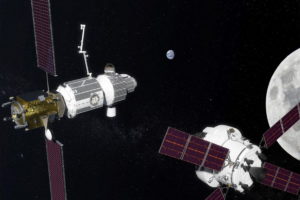
2019 will likely be a busy year for NASA. At the Space Symposium conference in Colorado Springs, Colorado, Associate Administrator William Gerstenmaier announced that the agency will begin awarding contracts for its lunar “Gateway” program, with a goal of having four astronauts in orbit around the moon by 2025.
Bloomberg reports that NASA has begun the process of constructing the Lunar Orbital Platform-Gateway, beginning with contracts for power and propulsion components, followed by habitation, logistics, and airlocks. The components will be launched and the Gateway constructed in space beginning in 2022.
“The Lunar Orbital Platform-Gateway will give us a strategic presence in lunar space. It will drive our activity with commercial and international partners and help us explore the Moon and its resources,” said Gerstenmaier. “We will ultimately translate that experience toward human missions to Mars.”
The Orion spacecraft, developed by Lockheed Martin, will provide trips to the Gateway aboard the Space Launch System (SLS) rocket. “Development of the gateway has great momentum, and we are providing our expertise as NASA looks to industry to bring know-how to this important effort,” Lockheed said in a statement.
Exploration Mission-1 (EM-1), the first unmanned Orion test flight, is planned for 2019. Its three-week mission will take it within 62 miles of the lunar surface and then into orbit some 40,000 miles high before its return to Earth. A manned test flight is planned for 2023.
Future experiments will determine if water can be extracted from the lunar surface and used to create propellant for future missions. “We want to understand orbital mechanics around the moon,” Gerstenmaier said. “Doing things in this region, where gravity isn’t such a big driver … is a different way of operating.”
According to NASA, the Gateway will allow further lunar exploration and even a staging area for exploration of the solar system. “It will drive our activity with commercial and international partners and help us explore the Moon and its resources,” Gerstenmaier added. “We will ultimately translate that experience toward human missions to Mars.”
The moon’s gravity can also be used to slow spacecraft down after their six-month journey from the Red Planet, before re-entering the Earth’s atmosphere.
Gernstenmaier said the agency’s goals are realistic from a budgetary standpoint and added that collaboration with commercial partners will expand the opportunities and capabilities in deep space: “As long as we view the moon as a stepping stone and not an end goal, I think we’re OK”


